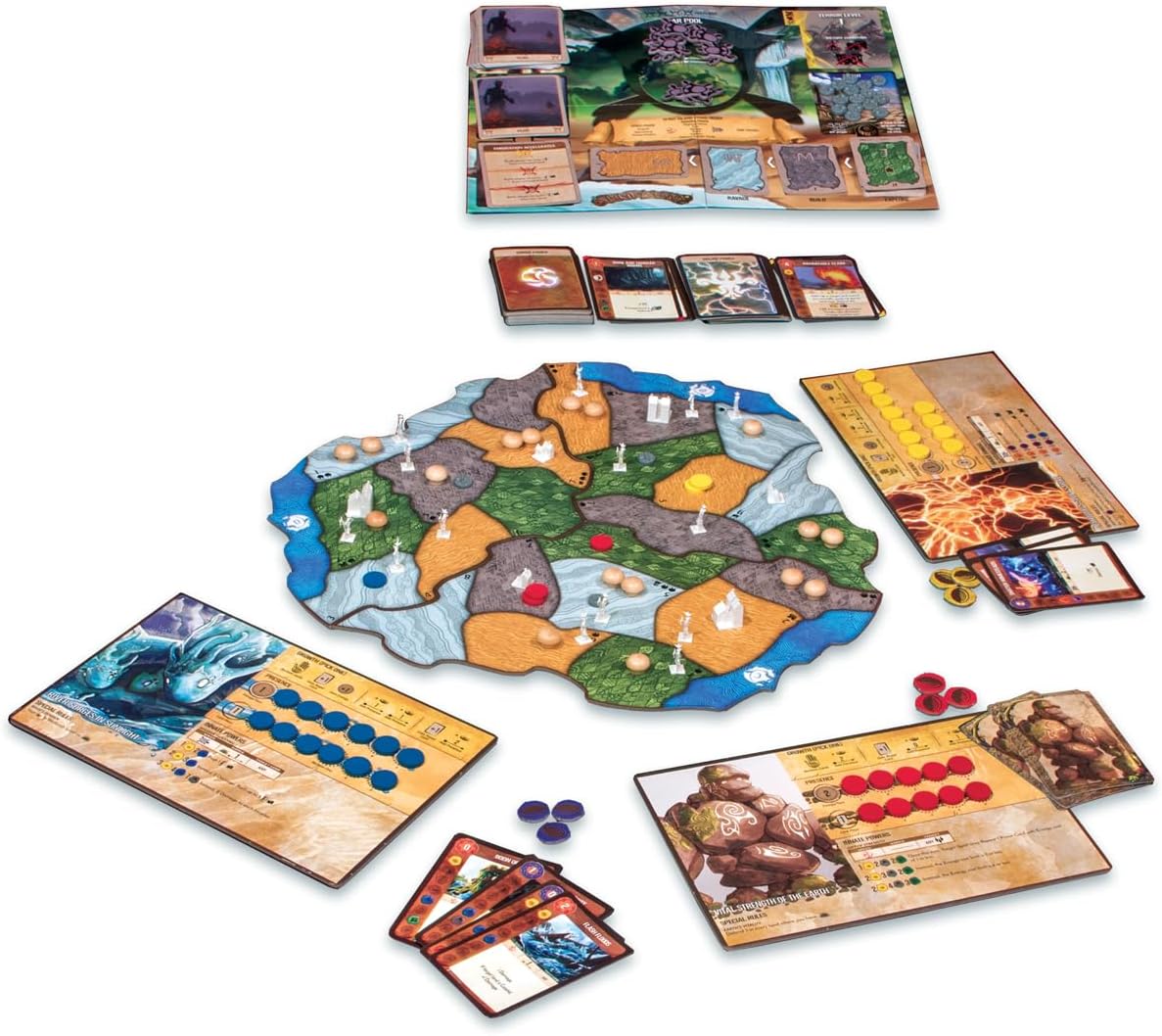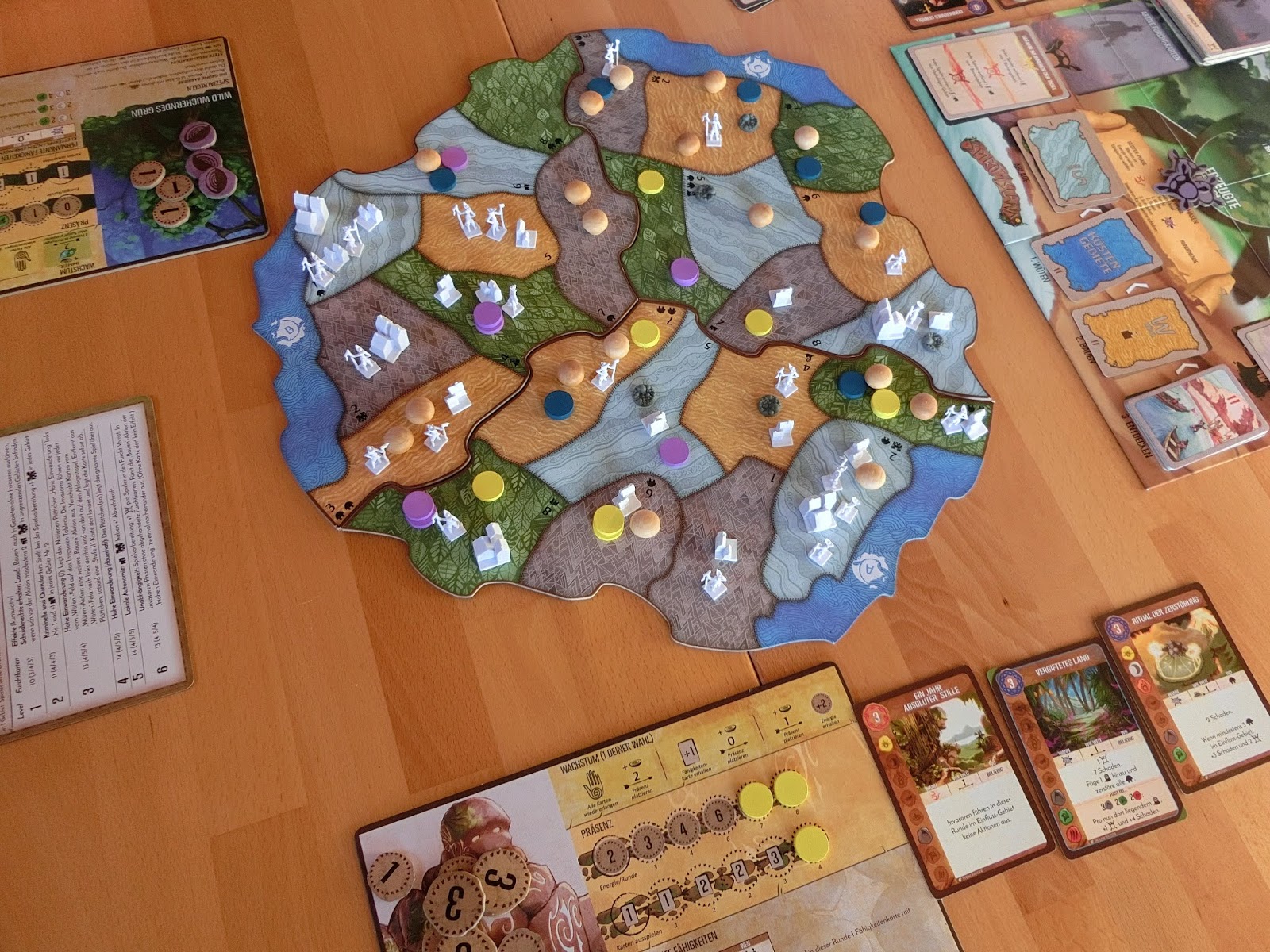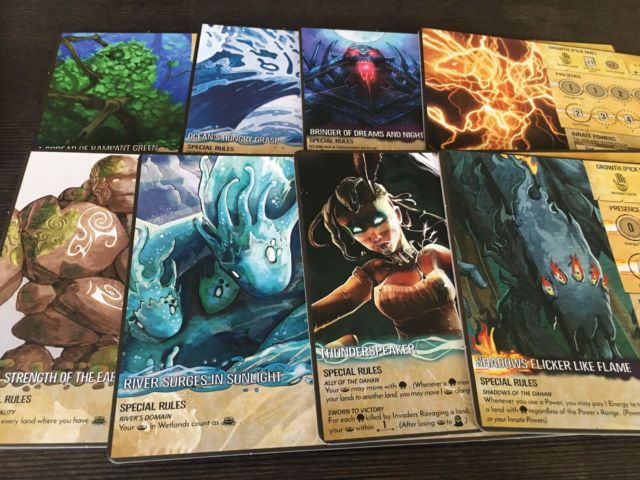In the heart of a mystical island shrouded in ancient secrets, players take on the roles of powerful spirits, guardians of this ethereal realm. As the island’s protectors, they must rise against the relentless tide of invaders, intent on colonizing and exploiting its pristine beauty.
Each spirit possesses unique abilities, drawn from the island’s elemental forces, and must use them strategically to thwart the invaders’ advances.
With every turn, the spirits collaborate to push back the encroaching settlers, defend sacred sites, and unleash the island’s wrath upon those who seek to despoil it. The island itself comes alive, responding to the spirits’ efforts with supernatural phenomena.
The battle for Spirit Island is an epic struggle between harmony and discord, a journey through a mystical world where nature’s fury is harnessed to preserve the island’s ancient and enigmatic wonders.
What’s included in Spirit Island?

- Game board representing the island.
- Spirit panels for each player.
- Tokens for fear, energy, and presence.
- A deck of power cards.
- Explorer, town, and city tokens for invaders.
- Blight tokens representing environmental damage.
- Invader cards.
How to play Spirit Island

The goal of Spirit Island is to repel invaders from the island and maintain a balance between nature’s elements while preventing the island’s destruction.
Setup
- Place the game board in the center and set up the island as directed by the scenario you choose. Each scenario offers unique challenges and objectives.
- Each player selects a spirit panel and takes tokens, presence, energy, and power cards based on their spirit’s abilities. They should also set up their individual player board according to their chosen spirit.
- Place the fear, energy, and presence tokens on the designated spaces on the board.
- Shuffle the invader cards and draw a set number based on the chosen difficulty level (as indicated in the scenario).
- Begin the game with the first invader phase.
Rules for Spirit Island
Spirit Island is played in rounds, with each round consisting of several phases.
- Spirit Phase
- Players take turns, starting with the first player and proceeding clockwise.
- During their turn, a player may take a series of actions, which can include:
- Playing power cards by spending energy.
- Gaining more presence on the island to expand their influence.
- Using innate powers specified by their spirit panel.
- Gaining energy from presence and cards.
- Players can choose the order in which they take these actions, allowing for strategic planning.
- Fast Powers Phase
- Players resolve any fast power cards they played during their Spirit Phase.
- These powers often provide immediate effects or allow for immediate reactions to events on the island.
- Invader Phase
- This is the main phase where invaders spread across the island. It includes the following steps:
- Reveal the top card of the invader deck.
- Resolve the instructions on the card, which dictate where and how invaders appear, build, and ravage.
- Players can play slow power cards and use innate powers during this phase to counteract the invaders’ actions.
- If blight would be added, players can choose to remove presence instead. If presence can’t be removed, add blight to the island and perform cascading ravages.
- Calculate the fear generated from blighting.
- Discard used invader cards, advancing the invader deck’s marker on the fear track.
- This is the main phase where invaders spread across the island. It includes the following steps:
- Slow Powers Phase
- Players resolve any slow power cards they played during their Spirit Phase.
- These powers often provide lasting effects or prepare the island for future challenges.
- Time Passes
- This is the end-of-round phase where players:
- Gain energy based on their presence on the board.
- Reclaim their discarded power cards.
- Advance fear cards if the fear track requirements are met.
- Remove a blight from the island’s blight card if it’s full.
- This is the end-of-round phase where players:
Winning and Losing: Players win “Spirit Island” if they meet the victory conditions specified in the scenario. These conditions usually involve terrorizing and eventually eradicating the invaders from the island. Players lose if the island becomes too blighted or other specific loss conditions are met.
For the official rules, see the link below:
All spirits in Spirit Island

- Lightning’s Swift Strike (Thunderspeaker): Harnesses the power of thunderstorms to aggressively combat invaders and generate fear.
- Vital Strength of the Earth (Vital Strength): Represents the resilience and vitality of the earth, specializing in defense and healing.
- Ocean’s Hungry Grasp (Ocean): Controls the flow of water to inundate regions and drown invaders.
- River Surges in Sunlight (River): Shapes the land by creating and manipulating rivers while controlling the movement of invaders.
- Shadows Flicker Like Flame (Shadows): Masters stealth and deception, hiding presence, and manipulating fear.
- Bringer of Dreams and Nightmares (Bringer): Induces nightmares, disrupts invader actions, and creates a sense of unease.
- Serpent Slumbering Beneath the Island (Serpent): Awakens the island’s hidden power, using serpent tokens to create strongholds and defend the land.
- Thunderspeaker (Heart of the Wildfire): Wields the destructive force of wildfire and utilizes it to drive invaders away.
- Sharp Fangs Behind the Leaves (Fangs): Represents the primal and aggressive spirit of the wild, specializing in beast attacks and causing fear.
- Keeper of the Forbidden Wilds (Keeper): Protects the untouched parts of the island, using the power of the wilds to deter invaders.
- Downpour Drenches the World (Downpour): Controls the rain and fog to obscure the invaders’ vision and weaken their forces.
- Many Minds Move as One (Many Minds): Unites the island’s animals to attack invaders and amplify the power of the spirits.
- Spread of Rampant Green (Spread): Creates lush and overgrown areas to isolate invaders and accelerate their demise.
- A Spread of Rampant Green (Spread of Rampant Green): A thematic variant of Spread with a different playstyle.
- Lure of the Deep Wilderness (Lure): Manipulates the island’s wildlife and tempts invaders into dangerous regions.
- Sharp Fangs (Fangs): A thematic variant of Sharp Fangs Behind the Leaves with a different playstyle.
- Shifting Memory of Ages (Shifting Memory): Utilizes the island’s history and memories to affect the past, present, and future of the land.
- Heart of the Wildfire (Heart of the Wildfire): A thematic variant of Thunderspeaker with a different playstyle.
- A Spread of Rampant Green (A Spread of Rampant Green): A thematic variant of Spread with a different playstyle.
- Serpent Slumbering Beneath the Island (Serpent Slumbering): A thematic variant of Serpent Slumbering Beneath the Island with a different playstyle.
Strategies to succeed in the game

- Cooperate and Communicate:
- Effective communication is vital. Discuss your spirit’s strengths, weaknesses, and intended actions with your fellow players.
- Plan together to maximize your spirits’ abilities and coordinate defense efforts.
- Presence Placement:
- Expand your presence strategically. Placing presence in key regions allows you to exert more control over the island.
- Prioritize regions with high invader presence or those at risk of blight.
- Power Card Selection:
- Choose power cards that complement your spirit’s strengths and the overall strategy. Consider a mix of offense, defense, and utility powers.
- Adapt your power card choices to the evolving situation on the island.
- Target High-Priority Areas:
- Focus your efforts on regions with towns and cities. These are the primary sources of invaders and should be your top priority for defense.
- Contain and isolate invaders in these regions to prevent them from spreading.
- Generate Fear:
- Fear generation is essential. Fear cards can provide valuable benefits, such as delaying the invaders’ actions or weakening them.
- Utilize powers and strategies that generate fear consistently.
- Manage Blight:
- Blight is a significant threat. Avoid adding blight whenever possible, as it accelerates the island’s decay.
- Remove blight when necessary, and prioritize restoring regions with blight before they cascade into adjacent areas.
- Coordinate Spirit Abilities:
- Combine your spirit’s unique powers with those of other spirits to create synergistic effects.
- Plan actions that enhance your allies’ abilities and mitigate the invaders’ actions.
- Adapt to Invader Actions:
- Pay attention to the invaders’ actions and adapt your strategy accordingly. Respond to emerging threats promptly.
- Focus on mitigating ravages and preventing builds to slow the invaders’ progress.
- Fear Cards and Fear Levels:
- Keep track of the fear level. When the fear level advances, it can grant you fear cards that provide powerful one-time effects.
- Use fear cards strategically to gain an advantage or disrupt the invaders’ plans.
- Balance Elemental Tracks:
- Balance your elemental tracks to ensure you have access to a variety of elements. This allows you to use a wider range of power cards.
- Elements play a crucial role in activating innate powers and playing specific power cards.
- Plan for the Late Game:
- “Spirit Island” often gets more challenging as the game progresses. Consider long-term strategies to address late-game threats.
- Develop a plan to push back against the invaders’ escalating forces.
- Scenario-Specific Strategies:
- Adapt your strategies to the scenario’s specific victory conditions and challenges. Some scenarios may require unique approaches.
- Learn from Experience:
- “Spirit Island” rewards experience and knowledge of spirit abilities, invader behaviors, and card interactions.
- After each game, reflect on what worked and what didn’t to improve your future strategies.